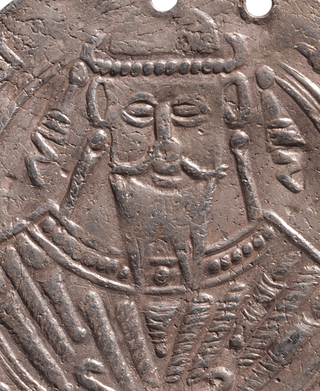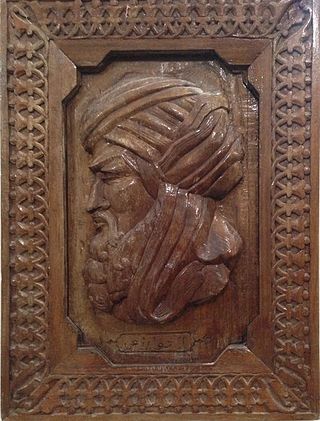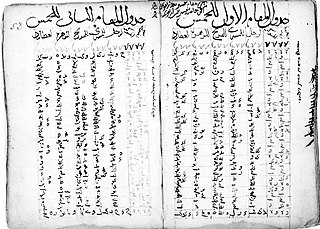Related Research Articles

Year 861 (DCCCLXI) was a common year starting on Wednesday of the Julian calendar.
Thābit ibn Qurra ; 826 or 836 – February 19, 901, was a Muslim polymath known for his work in mathematics, medicine, astronomy, and translation. He lived in Baghdad in the second half of the ninth century during the time of the Abbasid Caliphate.

The House of Wisdom, also known as the Grand Library of Baghdad, was believed to be a major Abbasid-era public academy and intellectual center in Baghdad. In popular reference, it acted as one of the world's largest public libraries during the Islamic Golden Age, and was founded either as a library for the collections of the fifth Abbasid caliph Harun al-Rashid in the late 8th century or as a private collection of the second Abbasid caliph al-Mansur to house rare books and collections of poetry in the Arabic language. During the reign of the seventh Abbasid caliph al-Ma'mun, it was turned into a public academy and a library. Finally, it is destroyed in 1258 during the Mongol siege of Baghdad. The primary sources behind the House of Wisdom narrative date between the tenth and thirteenth centuries, and most importantly include the references in Ibn al-Nadim's al-Fihrist.

Ja'far ibn Muhammad ibn Harun ; March 822 – 11 December 861), commonly known by his regnal name al-Mutawwakil ala Allah, was the tenth Abbasid caliph, ruling from 847 until his assassination in 861. He succeeded his brother, al-Wathiq, and is known for expanding the empire to its maximum extent. He was deeply religious, and is remembered for discarding the Muʿtazila, ending the Mihna, and releasing Ahmad ibn Hanbal. He is also known for his tough rule, especially with respect to non-Muslim subjects.

Abū al-ʿAbbās Aḥmad ibn Muḥammad ibn Kathīr al-Farghānī also known as Alfraganus in the West, was an astronomer in the Abbasid court in Baghdad, and one of the most famous astronomers in the 9th century. Al-Farghani composed several works on astronomy and astronomical equipment that were widely distributed in Arabic and Latin and were influential to many scientists. His best known work, Kitāb fī Jawāmiʿ ʿIlm al-Nujūmi, was an extensive summary of Ptolemy's Almagest containing revised and more accurate experimental data. Christopher Columbus used Al Farghani’s calculations for his voyages to America. In addition to making substantial contributions to astronomy, al-Farghani also worked as an engineer, supervising construction projects on rivers in Cairo, Egypt. The lunar crater Alfraganus is named after him.

Muhammad ibn Musa al-Khwarizmi, often referred to as simply al-Khwarizmi, was a Persian polymath who produced vastly influential Arabic-language works in mathematics, astronomy, and geography. Hailing from Khwarazm, he was appointed as the astronomer and head of the House of Wisdom in the city of Baghdad around 820 CE.
Muhammad ibn Ibrahim ibn Habib ibn Sulayman ibn Samra ibn Jundab al-Fazari was an Arab philosopher, mathematician and astronomer.
Yaʿqūb ibn Ṭāriq was an 8th-century Persian astronomer and mathematician who lived in Baghdad.
This timeline of science and engineering in the Muslim world covers the time period from the eighth century AD to the introduction of European science to the Muslim world in the nineteenth century. All year dates are given according to the Gregorian calendar except where noted.
The three brothers Abū Jaʿfar, Muḥammad ibn Mūsā ibn Shākir ; Abū al‐Qāsim, Aḥmad ibn Mūsā ibn Shākir and Al-Ḥasan ibn Mūsā ibn Shākir, were Persian scholars who lived and worked in Baghdad. They are collectively known as the Banū Mūsā.

A zij is an Islamic astronomical book that tabulates parameters used for astronomical calculations of the positions of the sun, moon, stars, and planets.

The Habbari were an Arab dynasty that ruled much of Greater Sindh, as a semi-independent emirate from 854 to 1024. Beginning with the rule of 'Umar bin Abdul Aziz al-Habbari in 854 CE, the region became semi-independent from the Abbasid Caliphate in 861, while continuing to nominally pledge allegiance to the Abbasid Caliph in Baghdad. The Habbari ascension marked the end of a period of direct rule of Sindh by the Umayyad and Abbasid Caliphates, which had begun in 711 CE.
Zīj as-Sindhind is a work of zij brought in the early 770s AD to the court of Caliph al-Mansur in Baghdad from India. Al-Mansur requested an Arabic translation of this work from the Sanskrit. The 8th-century astronomer and translator Muḥammad ibn Ibrāhīm al-Fazārī is known to have contributed to this translation. In his book Ṭabaqāt al-ʼUmam "Categories of Nations", Said al-Andalusi informs that others who worked on it include ibn Sa'd and Muhammad ibn Musa al-Khwarizmi. He adds that its meaning is al-dahr al-dahir.
The Golden Age of Islam, which saw a flourishing of science, notably mathematics and astronomy, especially during the 9th and 10th centuries, had a notable Indian influence.
Ali ibn Sulayman al-Hashimi, known as al-Hashimi, was an Islamic astronomer and mathematician, who flourished during the late 9th century.
Ibn al‐Ādamī, was a 10th-century Islamic astronomer who wrote an influential work of zij based on Indian sources. The book, now lost, uses the Indian methods found in the Sindhind. The 11th-century historian Sa'id al-Andalusi informs us that the theory of trepidation that became known to Europe and was ascribed to Thabit ibn Qurra can be found instead in the Zij of Ibn al-Adami, who himself may have known of this theory from Thabit's grandon, Ibrahim ibn Sinan. Ibn al-Adami is also the source for the story of how Indian astronomy reached the court of Caliph al-Mansur in the early 770s in Baghdad.

The Abbasid dynasty or Abbasids were an Arab dynasty that ruled the Abbasid Caliphate between 750 and 1258. They were from the Qurayshi Hashimid clan of Banu Abbas, descended from Abbas ibn Abd al-Muttalib. The Abbasid Caliphate is divided into three main periods: Early Abbasid era (750–861), Middle Abbasid era (861–936) and Later Abbasid era (936–1258). A cadet branch of the dynasty also ruled as ceremonial rulers for the Mamluk Sultanate as Caliph (1261–1517), until their conquest by the Ottoman Empire.
Yahya ibn Abi Mansur, also called Bizist, son of Firuzan was a senior Persian official from the Banu al-Munajjim family, who served as an astronomer and an astrologer at the court of Abbasid caliph al-Ma'mun. Since his father Abu Mansur Aban was an astrologer in service of caliph al-Mansur, it can be concluded that Yahya spent his childhood in Baghdad.
References
- ↑ Saliba, George (1995). "Introduction". A History of Arabic Astronomy: Planetary Theories During the Golden Age of Islam. New York University Studies in Near Eastern Civilization (New ed.). New York and London: New York University Press. p. 14. ISBN 0-8147-8023-7.
- ↑ Long, Matthew (2014). "Sanad ibn ʿAlī". In Kalin, Ibrahim (ed.). The Oxford Encyclopedia of Philosophy, Science, and Technology in Islam. Vol. 1. Oxford University Press. pp. 217–218. ISBN 978-0-19-935843-4.
- ↑ "Sanad ibn Ali". islamsci.mcgill.ca.
- ↑ Lowe, Roy; Yasuhara, Yoshihito (2016-10-04). The Origins of Higher Learning: Knowledge networks and the early development of universities. Taylor & Francis. p. 216. ISBN 978-1-317-54327-5.